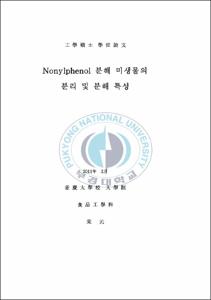Nonylphenol 분해 미생물의 분리 및 분해 특성
- Alternative Title
- Isolation and Characterization of Nonylphenol-degrading Microorganism
- Abstract
- Nonylphenol (NP), a breakdown product of nonylphenol ethoxylates (NPEs), is a subset of the alkylphenols and widely used as a industrial surfactant. This compound is classified as a xenobiotic and considered as a controversial pollutant. In the environment, NP has been detected widely in untreated sewage or waste water streams. It has been known that NP is toxic to many aquatic organisms and also well known for its endocrine system disrupting potential. Extremely low concentrations of NP would result in any detectable estrogenic effects in animals and humans. Due to its environmental concerns, it has been replaced by more expensive alcohol ethoxylates, which is less problematic environmentally. To remove toxic organic compounds, both biological and chemical treatments have been suggested as an environmental friend method. Bioremediation of the toxic compounds, using microbes or enzymes produced from the microorganism is often considered as economically and environmentally favorable method. Therefore, many efforts have been performed to isolate bacteria capable of degrading NP. However, there is no obvious report about the biodegradation of NP. With the increase of necessity for eco-friendly decomposition against toxic organic compounds, this study was conducted to isolate NP-degrading microorganism from aqueous environment. NP-degrading microbes were isolated through NP-containing enrichment culture from various sources such as sewage, waterweed, and sediment. Finally, a microbial consortium, SW-3, capable of degrading NP with high efficiency was selected from the mixture sample. Microbial consortium SW-3 was able to degrade over 99% of 100 ppm NP in the culture media for 40 days incubation at 25℃. Considering above result, It was concluded that microbial consortium SW-3 utilized NP as a single carbon source. The microbial consortium obtained in this study would be useful to develope an eco-friend bioremediation technology for NP degradation.
- Issued Date
- 2011
- Awarded Date
- 2011. 2
- Type
- Dissertation
- Publisher
- 부경대학교
- Alternative Author(s)
- Song, Won
- Affiliation
- 부경대학교 일반대학원
- Department
- 대학원 식품공학과
- Advisor
- 김영목
- Table Of Contents
- 서 론 1
1. 내분비계 장애물질 (Endocrine disruptors) 1
2. 노닐페놀 (Nonylphenol) 5
3. Bioremidiation 9
4. 연구목표 13
재료 및 방법 14
1. 실험재료 14
1.1. 시료 14
1.2. 사용시약 16
1.3. 배양 및 균주 분리용 배지 16
2. 실험방법 19
2.1. 시료의 배양 19
2.2. 증균배양 19
2.3. Nonylphenol 추출 및 HPLC 분석 20
2.4. Nonylphenol 분해 균주의 동정 23
결과 및 고찰 24
1. Nonylphenol 분해 컨소시엄 균주의 분리 24
1.1. Noylphenol 분해 컨소시엄 균주 SW-3의 생육도 측정 26
1.2. 컨소시엄 균주 SW-3의 nonylphenol 분해율 측정 28
2. 컨소시엄 균주 SW-3로부터 nonylphenol 분해 단일균주 분리 33
2.1. 컨소시엄 균주 SW-3에서 분리한 균주들의 특징 35
2.2. 컨소시엄 균주 SW-3에서 분리한 균주들의 동정 40
2.3. 분리균주의 nonylphenol 분해율 측정 49
요 약 56
감사의 글 58
참 고 문 헌 60
- Degree
- Master
- Files in This Item:
-
-
Download
 Nonylphenol 분해 미생물의 분리 및 분해 특성.pdf
기타 데이터 / 1.9 MB / Adobe PDF
Nonylphenol 분해 미생물의 분리 및 분해 특성.pdf
기타 데이터 / 1.9 MB / Adobe PDF
-
Items in Repository are protected by copyright, with all rights reserved, unless otherwise indicated.